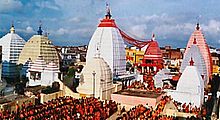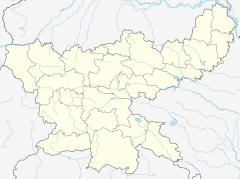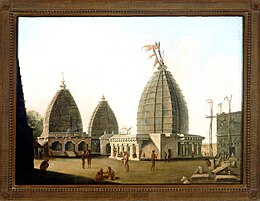| Baidyanath Temple | |
|---|---|
| Baidyanath Jyotirlinga | |
 Pyramid shaped Shikhara of the temple Pyramid shaped Shikhara of the temple | |
| Religion | |
| Affiliation | Hinduism |
| District | Deoghar |
| Deity | Shiva |
| Festivals | Maha Shivaratri, Shravani Mela |
| Governing body | Baba Baidyanath Temple Management Board |
| Location | |
| Location | Deoghar |
| State | Jharkhand |
| Country | India |
 | |
| Geographic coordinates | 24°29′33″N 86°42′00″E / 24.49250°N 86.70000°E / 24.49250; 86.70000 |
| Architecture | |
| Creator | Raja Puran Mal |
| Temple(s) | 22 |
| Website | |
| babadham.org | |

Baidyanath Temple (IAST: Baidyãnath), also known as Baba Baidyanath Dham, is a Hindu temple dedicated to Shiva. It is located in Deoghar, in the Santhal Parganas division of the Indian state of Jharkhand. The temple complex comprises the central shrine of Baba Baidyanath along with 21 additional temples. It is significant to the Hindu sects of Shaivism as this temple is referred to as one of the twelve Jyotirlingas.
Legend
According to the legends, Ravana was performing penance in the Himalayan region to appease Shiva. He offered nine of his heads as an offering to Shiva. As he was to sacrifice his tenth head, Shiva appeared before him and expressed satisfaction with the offering. Then, Shiva asked what boon he desired. Ravana asked to take the "Kamna Linga' to the island of Lanka and expressed his desire to take Shiva from Kailash to Lanka.
Shiva agreed to Ravana's request but with a condition. He said that if the lingam was placed en route, it would become the permanent abode of the deity and could never be moved.
Celestial gods became worried upon hearing that Shiva had departed from his abode on Mount Kailash. They sought a resolution from Vishnu. Vishnu asked Varuna, the deity associated with water, to enter Ravana's stomach through achamana, a ritual that involves sipping water from the palm of one's hand. As a consequence of performing achaman, Ravana departed for Lanka with the lingam and felt the need to urinate in the vicinity of Deoghar.
The story states that Vishnu took the form of a Shepherd named Baiju Gadariya. While Ravana went to perform Surya Namaskaram, he gave a lingam to this cowherd. Due to the presence of Varun Dev, Ravana took a very long time. Baiju got angry, having to wait for Ravana, for a very long time. He then positioned the lingam on the ground and left the place. Upon returning, Ravana attempted to pick up the lingam, but was unsuccessful in his endeavor. Ravana became upset after realizing this was the doing of Lord Vishnu and proceeded to press his thumb onto the lingam before departing which partially damaged the Shiv Lingam. The Shiva lingam was then worshipped by Brahma, Vishnu, and other deities and they constructed the Baidyanath Temple. Since then, Mahadev has taken up residence in Deoghar as the embodiment of the Kamna Linga.
Location of Baidyanath Jyotirlinga
Vaidyanatham Chitabhoomau (1/21-24) and Shivamaha puran Shatarudra Samhita (42/1-4) are the ancient verses that identify the location of Vaidyanth Jyotirlinga. According to which Shri Vaidyanatham is in 'Chitabhoomi', Dwadasha jyotirlinga stotram, Adi Sankaracharya has praised Shri Vaidyanath Jyotirlinga location in following verses, before Shivamaha puran Shatarudra Samhita as following:
Sourashtre Somanadham, cha Sri Shaile Mallikarjunam, Ujjayinyam Maha Kalam, Omkaram, amaleshwaram, Vaidyanatham Chitabhumau, Dakinyam Bhimasankaram, Sethubandhe thu Ramesam, Nagesam thu Darukavane, Varanasyam thu Viswesam, Trayambakam Gouthami thate, Himalaye thu Kedaram, Ghushmesam cha Shivalaye, Ethani Jyothirlingani sayam pratha paden nara, Saptha janma krutham papam smaranena vinasyathi.
"Parlam Vaidyanatham cha" instead of "Vaidyanatham Chitabhumau" is an alternative reading for it.
Adi Shankaracharya further evaluates the above main verse as below:
Poorvottare prajwalika nidhaane
sada vasantam girija sametam
suraasuraaradhita paada padmam
shri vaidyanaatham tamaham namaami
This states that:
I salute that Vaidyanatha, Whose lotus feet are worshipped By all asuras and devas and who lives in a place of eternal shine, in the north east of (Vaidyanatham) of Chitabhoomi, along with his consort Parvathi.
पूर्वोत्तरे प्रज्वलिकानिधाने सदा वसन्तं गिरिजासमेतम्। सुरासुराराधितपादपद्मं श्रीवैद्यनाथं तमहं नमामि ॥
"भावार्थ":
जो भगवान् शंकर पूर्वोत्तर दिशा में चिताभूमि वैद्यनाथ धाम के अन्दर सदा ही पार्वती सहित विराजमान हैं, और देवता व दानव जिनके चरणकमलों की आराधना करते हैं, उन्हीं ‘श्री वैद्यनाथ’ नाम से विख्यात शिव को मैं प्रणाम करता हूँ ।
Also, Chitabhoomi indicates that, in the olden days, this was a funeral place where corpses were burnt, and post-death ceremonies were performed. This place could have been a center of tantric cults like Kapalika/Bhairava where Lord Shiva is worshipped significantly as shmashaan vaasin (meaning, one who resides in a crematorium), and a bhasma bhushita (meaning, smearing body with ashes of burnt bodies).
The Dvadashalinga Smaranam also mentions its location as the verse is Prachikam Vaidyanatham, i.e., Vaidyanatham is in east (prachi means east). Another version of Dvadasalinga Smaranam mentions its location in the verse Paralyam Vaidyanatham, i.e., Vaidyanatham is in Parali.The names and the locations of the 12 Jyotirlingas mentioned in the distorted version of Dvadasalinga Smaranam are:
Saurashtre Somanatham cha Shrishaile Mallikarjunam|
Ujjayinya Mahakalam Omkaramamaleshwaram||
Prajwalayam Vaidyanathancha Dakinyam Bheema Shankaram|
Setu Bandhe tu Raamesham, Naagesham Daarukavane||
Varanasyantu Vishwesham Tryambakam Gautami tate|
Himalaye tu Kedaaram, Ghrishnesham cha shivaalaye||
Etani jyotirlingani, Saayam Praatah Pathennarah|
Sapta Janma Kritam Papam, Smaranena Vinashyati||
Thus, the three temples claiming their shrines as 'real' jyotirlinga of Vaidyanath are
- Baidyanath temple at Deoghar, Jharkhand,
- Shri Vaijnath Temple at Parli, Maharashtra and
- Baijnath temple at Baijnath, Himachal Pradesh.
Bhavishyapurana also describes Baidyanath as follows:
"Narikhande is a district abounding in thickets. It lies west of the Dwarikashwari River. It extends along the Panchakuta hills on its west, and approaches Kikta on the north. The forests are very extensive, chiefly of Sakhota, Arjuna and Sal trees with a plentiful addition of brushwood. The district is celebrated for the shrine of Baidyanath. The deity is worshiped by people from all quarters and is the source of every good in the present age."
It is believed that Shiva first manifested himself as a Jyotirlinga on the night of the Aridra Nakshatra, thus the special reverence for the Jyotirlinga. The same shrine of Vaidyanath is considered one of 51 Shakti Peethas, where 'heart' of Sati (goddess) fell, after being broken apart by the Sudarshana Chakra of Lord Vishnu, from the body of Dakshayani (Sati), carried by the lovelorn, distraught Shiva, at the location on which the respective temple is built. Since the heart of Sati fell here, the place is also called as Hardapeetha. Here Sati is worshipped as Jayaa Durga (Victorious Durga) and Lord Bhairava as Vaidyanath or Baidyanath. Dakshayani was reborn as Parvati, daughter of Himaavat, king of the mountains, and his wife, the Devi Mena.
Jyotirlinga

According to Shiv Mahapuran, once Brahma (the Hindu God of creation) and Vishnu (the Hindu God of preservation) had an argument in terms of supremacy of creation. To test them, Shiva pierced the three worlds as a huge endless pillar of light, the jyotirlinga. Vishnu and Brahma split their ways to downwards and upwards respectively to find the end of the light in either direction. Brahma lied that he found out the end, while Vishnu conceded his defeat. Shiva appeared as the second pillar of light and cursed Brahma that he would have no place in ceremonies while Vishnu would be worshipped until the end of eternity. The jyotirlinga is the supreme partless reality, out of which Shiva partly appears. The jyothirlinga shrines, thus are places where Shiva appeared as a fiery column of light.
Originally there were believed to be 64 jyothirlingas while 12 of them are considered to be very auspicious and holy. Each of the twelve jyothirlinga sites take the name of the presiding deity — each considered a different manifestation of Shiva. At all these sites, the primary image is lingam representing the beginningless and endless Stambha pillar, symbolizing the infinite nature of Shiva. The twelve jyothirlinga are Somnath at Veraval in Gujarat, Mallikarjuna at Srisailam in Andhra Pradesh, Mahakaleswar at Ujjain in Madhya Pradesh, Omkareshwar in Madhya Pradesh, Kedarnath in Uttarakhand, Bhimashankar in Maharashtra, Viswanath at Varanasi in Uttar Pradesh, Triambakeshwar in Maharashtra, Baidyanath in Jharkhand, Nageshvara at Dwarka in Gujarat, Rameshwar at Rameswaram in Tamil Nadu, and Grishneshwar at Maharashtra.
Description of Temple

The Maa Parvati temple is tied up with the main temple, with huge red sacred threads which is unique and worthy of reverence, showing the unity of Shiva and Shakti. According to the stories narrated in the Shiva Purana, the holy Baidyanath temple resembles the unity of souls and thus fits marriage for Hindus.
The nearest railway station is Jasidih railway station, which is 7 km from Baidyanath temple. Jasidh is 311 km from Howrah/Sealdah on Patna route. On a normal day, the worshipping of Baidyanath Jyotirlingam begins at 4 AM. The temple doors open at this time. At 4:00 am the "patt" of Baidyanath Jyotirlingam opens and for the very sharp 15 minutes the "Panda" (priest's families) offer Kacha Jal to LORD SHIVA, during 4:15am to 5:40 am, the Head priest worships with Shodashopachar. Locals also call it Sarkari Pooja. Then the devotees begin their worship of the Shivalinga. The most interesting tradition is that priests of the temple pour kuchcha Jal upon the lingam first, and later on, the pilgrims pour water and offer flowers and Bilva leaf, upon the lingam. The Puja rituals continue until 3.30 PM. After this, the temple doors are closed. In the evening at 6 PM the doors are opened again for devotees/ pilgrims and the process of worshipping begins again. At this time Shringar Puja takes place. The temple closes at 9:00 pm on a normal day, but during Holy Shravan month, the timings are extended. Unlike Somnath or Rameshwaram or Srisailam, here the devotees can get satisfaction by offering Abhishek themselves on Jyotirlinga. The devotee can also buy Peda as prasad from Babadham. Peda is a local sweet and is the speciality of Deoghar. Babadham has a regular and well-maintained office to accept offerings and donations.
The Matsyapuran narrates the place as Arogya Baidyanathitee, the holy place where Shakti lives and assists Shiva in freeing people from incurable diseases. This whole area of Deoghar was under the rule of the Kings of Gidhaur who were much attached with this temple. Raja Bir Vikram Singh founded this princely state in 1266. In 1757 after the Battle of Plassey the officers of the East India Company paid their attention to this temple. An English man, Keating was sent to look at the administration of the temple. Mr. Keating, the first English collector of Birbhum, took interest in the administration of the temple. In 1788, under Mr. Keating's order Mr. Hesilrigg, his assistant, who was probably the first English man to visit the holy city, set out to supervise personally the collection of the pilgrim offerings and dues. Later, when Mr. Keating himself visited Babadham, he was convinced and forced to abandon his policy of direct interference. He handed over the full control of the temple to the hands of the high priest.
The amazing Havan Kund temple of Baba dham opens only once a year, there is a special tradition associated with the Navratri festival.
Connectivity
Nearest airport: Deoghar Airport
Nearest railway station: Deoghar and Jasidih
Shravan Mela and Kanwar yatra
Millions of pilgrims visit this shrine every year. It is famous for the mela of Shraavana (a month of the Hindu calendar), between July and August. About 8 to 10 million devotees visit the place from various parts of India and offer holy water of Ganges (Uttarvahini Ganga) to the deity collected from Ajgaibinath, Sultanganj, which is almost 108 km from Deoghar and Baidyanath. The water is also brought by the Kānvarias, who carry the water in Kavadi, and walk all the distance, on barefoot. You will find large crowds walking all the way carrying water. An unbroken line of people in saffron-dyed clothes stretches over the full 108 km for the month. The pilgrims are called Dak Bam and they do not stop even once in their journey from Ajgaibinath Temple located at Sultanganj, Bhagalpur district to Vaidyanath. Pilgrims to the temple later visit the Basukinath temple.
See also
- Ajgaibinath Temple
- Famous Hindu yatras
- Hindu pilgrimage sites in India
- List of Hindu festivals
- Padayatra
- Ratha Yatra
- Tirtha
- Tirtha and Kshetra
- Baidyanath Dham (Nepal)
References
- ^ "Baba Baidyanath Temple Complex". Archived from the original on 27 June 2015. Retrieved 5 April 2010.
- "जानें क्या है बाबा बैजनाथ धाम की कथा..." आज तक (in Hindi). 25 July 2016. Retrieved 4 April 2023.
- "The magic of the Internet". Imgur. Retrieved 7 August 2022.
- "The magic of the Internet". Imgur. Retrieved 7 August 2022.
- "Archived copy" (PDF). Archived from the original (PDF) on 6 August 2016. Retrieved 15 May 2019.
{{cite web}}: CS1 maint: archived copy as title (link) - "Dwadash Jyotirlinga Stotram". Archived from the original on 5 March 2012.
- "Sanskritssdvada2" (PDF). Archived from the original (PDF) on 6 August 2016. Retrieved 15 May 2019.
- Om Prakash Ralhan (1998). Encyclopaedia Of Political Parties, Volumes 33-50. Anmol Publications Pvt. Limited. ISBN 9788174888655.
- "Archived copy" (PDF). Archived from the original (PDF) on 6 August 2016. Retrieved 15 May 2019.
{{cite web}}: CS1 maint: archived copy as title (link) - "12 Jyotirlingas of Lord Shiv – Shree Hindu Temple and Community Centre – Hindu Mandir Leicester".
- "Sanskritssdvada1" (PDF). Archived from the original (PDF) on 6 August 2016. Retrieved 15 May 2019.
- Unecha, Santosh (21 April 2017). "Conflicts of Vaidyanath Jyotirlinga". PuneToPune. Retrieved 3 April 2023.
- 51 Shaktipeethas http://www.taramaa.net/shaktipeethas.htm Archived 2015-06-30 at the Wayback Machine
- 51 Shaktipeethas-History http://kumbhujjain.in/blog/temple/shakti-peeths/ Archived 2015-02-16 at the Wayback Machine
- ^ R. 2003, pp. 92-95
- Eck 1999, p. 107
- See: Gwynne 2008, Section on Char Dham
- ^ Lochtefeld 2002, pp. 324-325
- Harding 1998, pp. 158-158
- Vivekananda Vol. 4
- Chaturvedi 2006, pp. 58-72
- "Baba Baidyanath Temple . Babadham . Deoghar". Archived from the original on 27 June 2015. Retrieved 5 April 2010.
- "Baidyanath Jyotirlinga Shiva Temples".
- "Havan Kund temple of Baba dham opens only once a year, there is a special tradition". Prabhat Khabar. Retrieved 19 June 2024.
- "Distance from Sultanganj to Deoghar Jharkhand, Distances Between Sultanganj to Deoghar Jharkhand, Calculate Deoghar Jharkhand Distance from Sultanganj by Road, Travel Time Driving Direction Calculator from Sultanganj to Deoghar Jharkhand". Archived from the original on 2 June 2016. Retrieved 15 May 2019.
- Chaudhary, Pranavkumar (30 May 2004). "Administration gears up for Shravani Fair". The Times of India. Archived from the original on 11 August 2011. Retrieved 6 April 2010.
- "Month-long Shrawani Mela ends". The Times of India. 6 August 2009. Archived from the original on 11 August 2011. Retrieved 6 April 2010.
- Desk, Blitz India (17 July 2023). "PHOTOS: See picture of government worship in Ajgaibinath temple, Kanwariyas seen in Sultanganj on Monday". BLiTZ. Retrieved 22 July 2023.
{{cite web}}:|last=has generic name (help)
Notes
- Chaturvedi, B. K. (2006), Shiv Purana (First ed.), New Delhi: Diamond Pocket Books (P) Ltd, ISBN 81-7182-721-7
- Eck, Diana L. (1999), Banaras, city of light (First ed.), New York: Columbia University Press, ISBN 0-231-11447-8
- Gwynne, Paul (2009), World Religions in Practice: A Comparative Introduction, Oxford: Blackwell Publication, ISBN 978-1-4051-6702-4.
- Harding, Elizabeth U. (1998). "God, the Father". Kali: The Black Goddess of Dakshineswar. Motilal Banarsidass. pp. 156–157. ISBN 978-81-208-1450-9.
- Lochtefeld, James G. (2002), The Illustrated Encyclopedia of Hinduism: A-M, Rosen Publishing Group, p. 122, ISBN 0-8239-3179-X
- R., Venugopalam (2003), Meditation: Any Time Any Where (First ed.), Delhi: B. Jain Publishers (P) Ltd., ISBN 81-8056-373-1
- Vivekananda, Swami. "The Paris Congress of the History of Religions". The Complete Works of Swami Vivekananda. Vol. 4.
External links
- Official Website of Baba Baidyanath Temple Management Board Archived 17 May 2022 at the Wayback Machine
- Baidyanath Temple on Facebook
| Shaivism | |||||||||||
|---|---|---|---|---|---|---|---|---|---|---|---|
| History | |||||||||||
| Deities |  | ||||||||||
| Texts | |||||||||||
| Mantra/Stotra | |||||||||||
| Traditions | |||||||||||
| Festivals and observances | |||||||||||
| Shiva temples |
| ||||||||||
| Related topics | |||||||||||
| Hindu Temples in Jharkhand | |
|---|---|
| Bokaro | |
| Chatra | |
| Deoghar | |
| Dhanbad | |
| Dumka | |
| Giridih | |
| Ramgarh | |
| Ranchi | |
| Sahebganj | |
| Santhal Pargana division topics | |||||||||||||
|---|---|---|---|---|---|---|---|---|---|---|---|---|---|
| General |
| ||||||||||||
| Districts | |||||||||||||
| Subdivisions | |||||||||||||
| Community development blocks |
| ||||||||||||
| Rivers, waterfalls, dams | |||||||||||||
| Languages, people | |||||||||||||
| Transport | |||||||||||||
| Railway stations | |||||||||||||
| History | |||||||||||||
| Institutes of higher learning | |||||||||||||
| Lok Sabha constituencies | |||||||||||||
| Vidhan Sabha constituencies |
| ||||||||||||
| See also | |||||||||||||
| Other Divisions | |||||||||||||